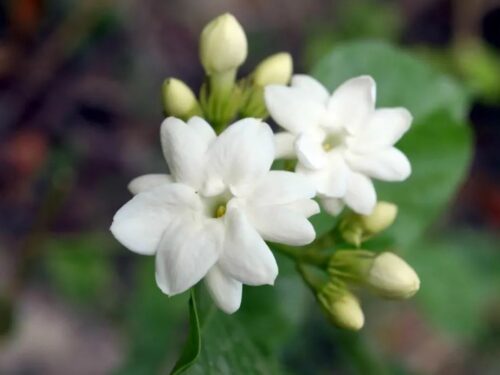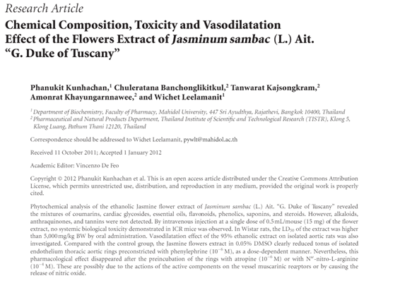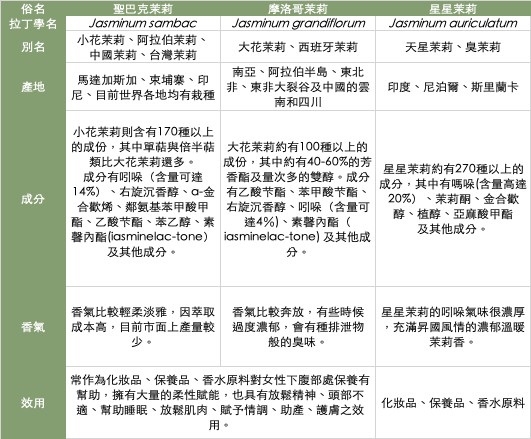
Jasmine sambac
Jasminum sambac
【Overview】
Origin | India
Botanical Family | Oleaceae
Plant Aroma | Original essential oil with a rich and delicate fragrance.
Extraction Part | Flowers
Extraction Method | Solvent extraction

Sacred Bak Jasmine essential oil is produced in India's humid and fertile, slightly acidic sandy soil. It belongs to the tropical monsoon climate with high temperatures throughout the year, and acidic soil predominates. Sacred Bak Jasmine prefers slightly acidic sandy soil, is not cold-resistant, and can tolerate full or partial sunlight. The flowering period is around June to September. During the mid-flowering stage when the flower buds are about to open into a "tiger claw" shape, it is harvested at around three or four in the afternoon when the fragrance is more intense, and the oil yield is higher. It is a common variety in India and is also known as the "Moonlight in the Forest."
There are many varieties of jasmine, so special attention is needed when choosing jasmine essential oil. Commonly found in essential oils are Moroccan Jasmine (Jasminum grandiflorum), Star Jasmine (Jasminum auriculatum), and Arabian Jasmine (Jasminum sambac). The original essence is obtained through solvent extraction.
Arabian Jasmine has a clear and distant fragrance, can "resist consumption," and has a bright tone, providing a continuous source of vitality.
【Main Benefits】
The indole component in Sacred Bak Jasmine essential oil helps enhance charm, Cis-Jasmone regulates oil secretion, bringing a sense of ease and tranquility. α-Phyllocladene is the source of a special sweet and clear fragrance, which can be detected at the beginning of the blooming, but this structure is easily destroyed by light and heat, hence the reason for harvesting it in the early morning to avoid the sun damaging the flower's fragrance.
➢ Its components include α-Phyllocladene, Indole (with a content of up to 14%), D-Cembrene, Methyl Anthranilate (5%), Methyl Benzoate (4-5%), Phenethyl Alcohol (2-3%), Jasminelactone, and other components.
【Component Analysis】
1. Indole

• Indole is an aromatic heterocyclic organic compound with C8H7N. It has a double-ring structure composed of a five-membered pyrrole ring and a six-membered benzene ring. Indole is widely distributed in the natural environment and can be produced by various bacteria as an intercellular signaling molecule.
• Benefits: It regulates various aspects of bacterial physiology (such as spore formation, plasmid stability, drug resistance, biofilm formation, and virulence).
Indole derivatives play important cellular functions, including neurotransmitters (e.g., serotonin).
• Uses: Indole and its derivatives are used in medical applications such as anti-tuberculosis, anti-malarial, metabolic regulation, anticonvulsant, blood pressure regulation, and anti-MRSA (Methicillin-resistant Staphylococcus aureus).
2. Cis-Jasmone

• Also known as Jasmine Ketone, it has a high content in Arabian Jasmine flowers. Cis-Jasmone has two isomers: cis and trans. Only the cis isomer exists in nature, while the trans isomer can only be synthesized artificially. Cis-Jasmone is a gentle component that adds a luxurious feeling and enhances charm. It can also regulate oil secretion, providing a sense of relaxation.
• Benefits: Calming, reduces muscle spasms, anti-anxiety, anti-depression; regulates oil secretion.
• Uses: Perfume raw material.
➢ Jasmine flower extract's chemical components have a vasodilatory effect.

➢ Comparison of Jasmines

【Market Applications】
◇ Uses/Characteristics
• Regulates physiological functions, soothes nerves, boosts confidence
• Antimicrobial, maintains moisture, relieves sensitive and delicate skin
• Regulates skin aging, smoothens wrinkles
• Smoothes stretch marks and marks caused by pregnancy, increases skin elasticity
• Blends fragrance and spices
1. Skincare Products
Benefits: Maintains moisture, soothes, enhances skin elasticity, regulates dry and sensitive skin, regulates skin aging, smoothens wrinkles.
Examples: Facial soap, cleansing mousse, toner, serum, emulsion, skin conditioner, moisturizer, eye cream, etc.
2. Body Care Products
Benefits: Antimicrobial, relieves inflammation of sensitive skin, regulates skin aging, fights stretch marks and marks caused by pregnancy, increases skin elasticity.
Examples: Shampoo, shower gel, bath salts, hand cream, skincare products, stretch mark cream, etc.
3. Daily Necessities
Benefits: Regulates physiological functions, soothes nerves, boosts confidence, optimism, and joy, can help with smooth childbirth, relieves pain, alleviates postpartum depression, aids in milk secretion, regulates male disorders.
Examples: Massage oil, essential oil spray, diffusers.
4. Environmental Cleaning Products
Benefits: Antimicrobial, purifies, removes odors.
Examples: Purifying spray, hand wash, perfume blends.
5. Food Industry
Also commonly used as flavoring agents and spices.
【Product Description】
◇ Formula Applications/Usage
• Solubility: Lipophilic (soluble in fats and oils)
• Recommended mixing method:
- Add at room temperature, no need for additional heating to avoid prolonged high temperatures.
- Add to the oil phase before emulsification when formulating cosmetics, and mix well before emulsification.
◇ Precautions
• Please adjust the usage ratio according to individual skin conditions.
• This product is a raw material, it is recommended to dilute before use.
• Before using on the face, please do a patch test on a small area of skin.
• Please use in normal doses.
